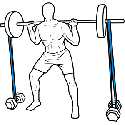Many people have seen the human flag on online before and been amazed at the testament of human strength. Before jumping in and trying to nail you first flag, make sure to you follow these quick pointers:
It’s important that you are able to stabilize your shoulder for an inverted hold so as not to injure yourself.
I) Begin facing the vertical bar or pole and grasping it with arms wider than shoulder width apart. The top hand can be in a cup grip, twisted grip, true grip or in the case of a tall set of parallel or stall bars, a T-grip.
II) Once the hands are in position, push out of the bottom shoulder while engaging (or pulling down) with the shoulder of the upper arm to rotate the body up and away from the pole. Think about trying to lengthen the distance from your ear to your shoulder on both sides to prevent sinking into or collapsing into your shoulders.
III) The chest should rotate up towards the ceiling as the body rotates out. Each shoulder and arm should be equally engaged in a balanced push and pull. If your head is coming closer to the bar as you do this rotational engagement that means that you are pulling more than you are pushing away. If anything this movement should create more distance between your head and the pole.
Do not kick or lift the legs off the ground but instead think of a string lifting the chest up towards the ceiling as the arms and shoulders equally push and pull to raise the body.
The goal is for the legs to raise off the ground but with the lift stemming from the shoulder engagement not from the hip flexors. Once this coordination of proper shoulder engagement is achieved you can start working on the tuck position. You should have someone to spot you on this inversion in the beginning.
Flag progressions:
The shoulder and bottom arm should be stacked directly underneath the body. Bottom arm bicep to same side ear will help you find this alignment. Initially the feet can be rested on the pole or bar to help you find your balance.
Your body should be in a straight line, like a handstand. Glutes should be engaged to prevent the hips from piking and abs engaged to prevent the back from arching.
If you start your horizontal descent with one leg bent it will usually make it easier to drop lower and hold longer as your strength builds.
Pro tips:
As you lower don’t rush to lower so far that you are unable to hold the position. Instead only lower as far as you can and hold for 5-10 seconds. Over time how low you can go and still hold will increase until you progress all the way to a fully horizontal flag.
The time it takes to progress from one step to the next varies significantly from person to person. Go at your own pace and take your time learning each step to prevent injury
We obviously recommend using RubberBanditz to assist in offsetting your bodyweight and maintaining straight legs. To use these, just loop your RubberBanditz resistance bands around top parallel bar if using p-bars or simply around vertical bar if using a pole. Place top leg through the band to offset a portion of body weight while working on building the strength to hold single or double straight leg flag.
This article was writting by our sponsored athlete, Elizabeth Blanchard (@elizabeth_bfit). Please visit her webiste at elizabethbfit.com for host of calisthenics and pole/aerial fitness education and inspiration.



